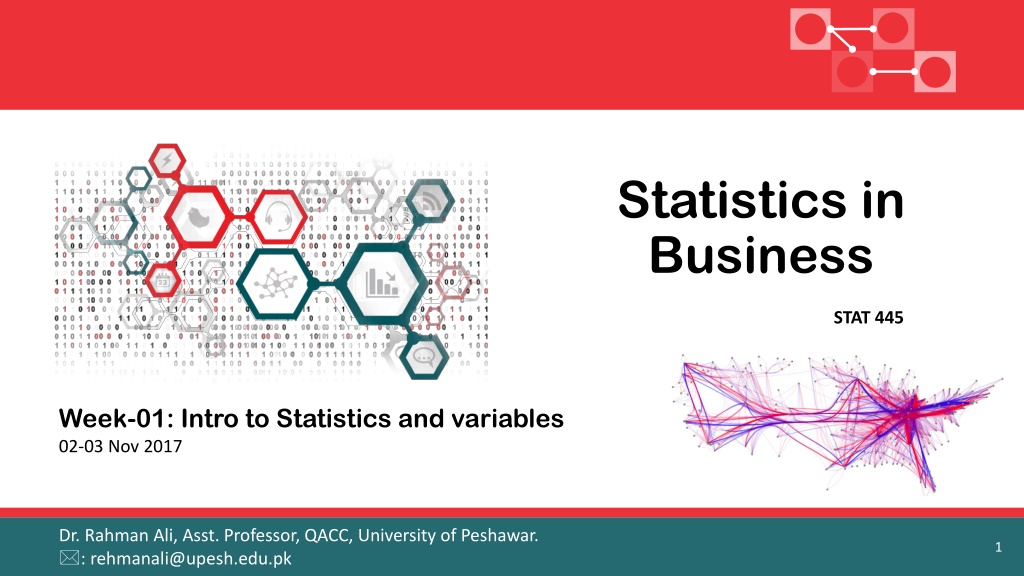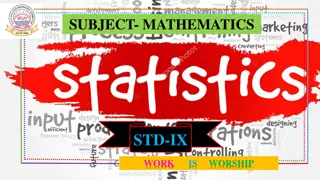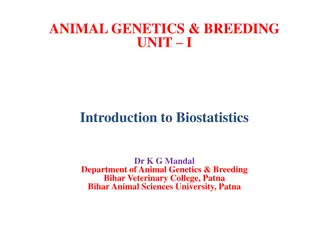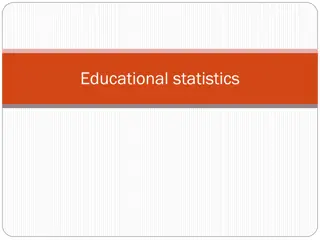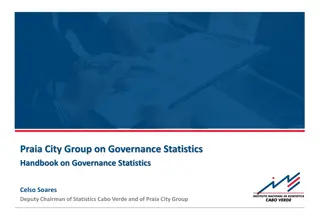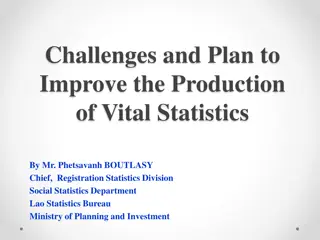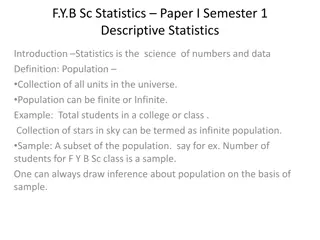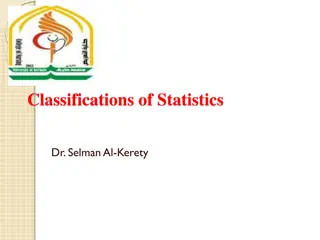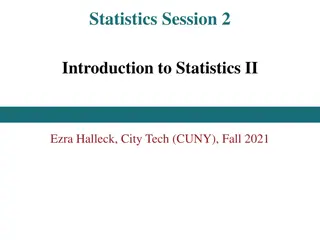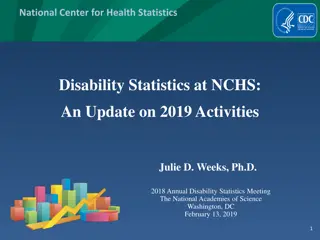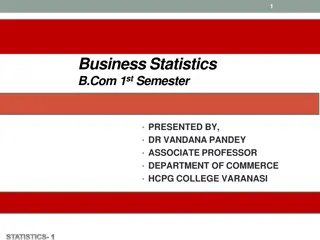Introduction to Statistics in Business: Key Concepts and Methods
Explore the fundamental concepts in statistics for business purposes, including descriptive and inferential statistics, populations and samples, types of variables, and the importance of statistical analysis. Dr. Rahman Ali, Assistant Professor at the University of Peshawar, delves into the meaning of statistics, characteristics of statistical data, and the distinction between descriptive and inferential statistics. Gain insights into the science of data collection, analysis, and interpretation, essential for making informed business decisions.
Download Presentation

Please find below an Image/Link to download the presentation.
The content on the website is provided AS IS for your information and personal use only. It may not be sold, licensed, or shared on other websites without obtaining consent from the author. Download presentation by click this link. If you encounter any issues during the download, it is possible that the publisher has removed the file from their server.
E N D
Presentation Transcript
Statistics in Business STAT 445 Week-01: Intro to Statistics and variables 02-03 Nov 2017 Dr. Rahman Ali, Asst. Professor, QACC, University of Peshawar. : rehmanali@upesh.edu.pk 1
Agenda Meaning of Statistics; Characteristics of Statistics; Descriptive and inferential Statistics; Populations and Samples; Importance of Statistics; Observations and Variables; Types of variables End Dr. Rahman Ali, Asst. Professor, QACC, University of Peshawar. : rehmanali@upesh.edu.pk 2
Meaning of statistics Definition-01 Science of collection, presentation, analysis, and reasonable interpretation of data. Definition-02 Statistics consists of a body of methods for collecting and analyzing data. (Agresti & Finlay, 1997) Questions: What kind and how much data How to organize the data How we can analyze the data That is, statistics provides methods for Design: of research studies Description: summarizing and exploring data Inference: Making predictions 3
Characteristics of Statistics 1. Statistics are Aggregate of Facts: 2. Statistics are Affected to a marked Extent by Multiplicity, of Causes: 3. Statistics are Numerically Expressed: 4. Statistics are Enumerated or estimated according to Reasonable Standards of Accuracy: 5. Statistics are Collected in a Systematic Manner: 6. Statistics for a Pre-determined Purpose: 7. Statistics are Capable of being Placed in Relation to each other: 4
Descriptive and inferential Statistics Descriptive statistics Defination-01: The descriptive statistics is concerned with describing or summarizing and the numerical properties of data Defination-02: Descriptive statistics consist of methods for organizing and summarizing information (Weiss, 1999) The methodology of descriptive statistics includes classification, tabulation, graphical representation and calculation of certain indicators such as mean, median, range, etc. which summaries certain important features of data Inferential statistics Inferential statistics, which is also referred to as statistical inference, is concerned with derivation of scientific inference about generalization of results from the study of a few particular cases. The methodology of inferential statistics includes point estimation, interval estimation and hypothesis testing http://www.yourarticlelibrary.com/education/statistics/statistics-meaning-characteristics-and- importance/91697
Descriptive and inferential Statistics http://www.yourarticlelibrary.com/education/statistics/statistics-meaning- characteristics-and-importance/91697
Importance of Statistics Importance of Statistics (i) Statistics in Planning: (ii) Statistics in Mathematics: (iii) Statistics in Economics: (iv) Statistics in Social Sciences: (v) Statistics in Trade: (vi) Statistics in Research Work: 1. They permit the most exact kind of description: 2. They force us to be definite: 3. They help us to summarize the results: 4. They enable us to draw general conclusions: 5. They enable us to make predictions: 6. They enable us to analyze some of the casual factors of the complex events. http://www.yourarticlelibrary.com/education/statistics/statistics-meaning-characteristics-and- importance/91697
Population Population The entire group of individuals is called the population. For example, a researcher may be interested in the relation between class size (variable 1) and academic performance (variable 2) for the population of third-grade children. Sample Usually populations are so large that a researcher cannot examine the entire group. Therefore, a sample is selected to represent the population in a research study. The goal is to use the results obtained from the sample to help answer questions about the population. 8
Some Definitions Some Definitions Variable - In statistics, a variable has two defining characteristics: A variable is an attribute that describes a person, place, thing, or idea. The value of the variable can "vary" from one entity to another. For example, a person's hair color is a potential variable, which could have the value of "blond" for one person and "brunette" for another. 1. Categorical/qualitative Qualitative variables take on values that are names or labels. The color of a ball (e.g., red, green, blue) or the breed of a dog (e.g., collie, shepherd, terrier) would be examples of qualitative or categorical variables. 2. Numeric/quantitative Quantitative variables are numeric. They represent a measurable quantity. For example, when we speak of the population of a city, we are talking about the number of people in the city - a measurable attribute of the city. Therefore, population would be a quantitative variable.
Some Definitions Some Definitions 3. Continuous variable If a variable can take on any value between its minimum value and its maximum value, it is called a continuous variable 4. Discrete variable Variables that can only take on a finite number of values are called "discrete variables." All qualitative variables are discrete. Some quantitative variables are discrete, such as performance rated as 1,2,3,4, or 5, or temperature rounded to the nearest degree.
Some Definitions Some Definitions Dependent variable If a variable can take on any value between its minimum value and its maximum value, it is called a continuous variable Independent variable Variables that can only take on a finite number of values are called "discrete variables." All qualitative variables are discrete. Some quantitative variables are discrete, such as performance rated as 1,2,3,4, or 5, or temperature rounded to the nearest degree.
Some Definitions Some Definitions Random variable If a variable can take on any value between its minimum value and its maximum value, it is called a continuous variable A Ranked variable Variables that can only take on a finite number of values are called "discrete variables." All qualitative variables are discrete. Some quantitative variables are discrete, such as performance rated as 1,2,3,4, or 5, or temperature rounded to the nearest degree.
Some Definitions Some Definitions Univariate Data When we conduct a study that looks at only one variable, we say that we are working with univariate data. Suppose, for example, that we conducted a survey to estimate the average weight of high school students. Since we are only working with one variable (weight), we would be working with univariate data. Bivariate data When we conduct a study that examines the relationship between two variables, we are working with bivariate data. Suppose we conducted a study to see if there were a relationship between the height and weight of high school students. Since we are working with two variables (height and weight), we would be working with bivariate data. Multivariate data Multivariate Data Analysis refers to any statistical technique used to analyze data that arises from more than one variable. This essentially models reality where each situation, product, or decision involves more than a single variable.
Observation and variables Observation and variables Observation We call a set of data derived from an object (experimental unit) an observation. Each object is measured according to various aspects, such as temperature, concentration of some constituents, frequency of occurrence of some phenomenon, etc
Observation Observation:A systematic method of data collection that relies on a researcher s ability to gather data through their senses Observe: To notice using a full range of appropriate senses. To see, hear, feel, taste, and smell 17
Head Start Program Study Facility visits Location Exterior Size of space Pictures on walls Amount of books Etc. 18
What You See Isn t Always What You Get Observation provides the opportunity for researchers to document actual behavior rather than responses related to behavior However, the observed can act differently when surveilled; and researchers observations are likely to be biased by their own worldviews 19
Types of Observation Non-participant: In this role, the researcher does not become, nor aims to become an integral part of the system or community they are observing Participant:In this role, the researcher is, or becomes, a part of the team, community, or cultural group they are observing 21
Types of Observation Candid:The researcher offers full disclosure of the nature of their study and the role the observations will play in their research Covert:Can be non-participant, i.e.) watching pedestrian behaviour at an intersection, or watching interactions at a school playground. But they can also be participatory. This involves researchers going undercover in an attempt to get a real sense of a situation, context, or phenomenon 22
Types of Observation Structured: Highly systematic and often rely on predetermined criteria related to the people, events, practices, issues, behaviours, actions, situations, and phenomena being observed. Semi-structured: Observers generally use some manner of observation schedule or checklist to organize observations, but also attempt to observe and record the unplanned and/or the unexpected. Unstructured:Observers attempt to observe and record data without predetermined criteria. 23
The Observation Process The collection of credible data through observation requires: thorough planning careful observation thoughtful recording reflexive review considered refinements appropriate analysis 24
Experimentation Involvement of someone by himself/herself in the process of caring that task and noting the results/outcome is called experimentation. 25
Sampling Recall that statistical inference permits us to draw conclusions about a population based on a sample. Sampling (i.e. selecting a sub-set of a whole population) is often done for reasons of cost(it s less expensive to sample 1,000 television viewers than 100 million TV viewers) and practicality (e.g. performing a crash test on every automobile produced is impractical). In any case, the sampled population and the target population should be similar to one another. 5.26
Sampling Plans A sampling plan is just a method or procedure for specifying how a sample will be taken from a population. We will focus our attention on these three methods: Simple Random Sampling, Stratified Random Sampling, and Cluster Sampling. Random sampling,by far, is the most common one used. 5.27
Simple Random Sampling A simple random sample is a sample selected in such a way that every possible sample of the same size is equally likely to be chosen. Drawing three names from a hat containing all the names of the students in the class is an example of a simple random sample: any group of three names is as equally likely as picking any other group of three names. VERY EASY TO DEFINE! VERY, VERY DIFFICULT TO DO! Random sample of 100 cokes bottles today at the coke plant. Random sample of 50 pine trees in a 1000 acre forest. Random sample of 5 deer in a national forest. 5.28
Simple Random Sampling A government income tax auditor must choose a sample of 5 of 11 returns to audit [Can do many different ways] Person baker 0.87487 george 0.89068 ralph 0.11597 mary 0.58635 sally 0.34346 joe 0.24662 andrea 0.47609 mark 0.08350 greg 0.53542 aaron 0.37239 kim 0.73809 Generate Random # Sorted Random # Person 1 mark 2 ralph 3 joe 4 sally 5 aaron andrea greg mary kim baker george 0.08350 0.11597 0.24662 0.34346 0.37239 0.47609 0.53542 0.58635 0.73809 0.87487 0.89068 5.29
Stratified Random Sampling A stratified random sample is obtained by separating the population into mutually exclusive sets, or strata, and then drawing simple random samples from each stratum. Strata 1 : Gender Male Female 20-30 31-40 41-50 51-60 > 60 Strata 2 : Age < 20 Strata 3 : Occupation professional clerical blue collar other We can acquire about the total population, make inferences within a stratum or make comparisons across strata 5.30
Stratified Random Sampling After the population has been stratified, we can use simple random sampling to generate the complete sample: If we only have sufficient resources to sample 400 people total, we would draw 100 of them from the low income group if we are sampling 1000 people, we d draw 50 of them from the high income group. 5.31
Cluster Sampling A cluster sample is a simple random sample of groups or clusters of elements (vs. a simple random sample of individual objects). This method is useful when it is difficult or costly to develop a complete list of the population members or when the population elements are widely dispersed geographically. Used more in the old days . Cluster sampling may increase sampling error due to similarities among cluster members. 5.32
Sample Size Numerical techniques for determining sample sizes will be described later, but suffice it to say that the larger the sample size is, the more accurate we can expect the sample estimates to be. 5.33
Sampling and Non-Sampling Errors Two major types of error can arise when a sample of observations is taken from a population: sampling error and nonsampling error. Sampling error refers to differences between the sample and the population that exist only because of the observations that happened to be selected for the sample. Random and we have no control over. Nonsampling errors are more serious and are due to mistakes made in the acquisition of data or due to the sample observations being selected improperly. Most likely caused be poor planning, sloppy work, act of the Goddess of Statistics, etc. 5.34
Sampling Error Sampling error refers to differences between the sample and the population that exist only because of the observations that happened to be selected for the sample. Increasing the sample size will reduce this type of error. 5.35
Nonsampling Error Nonsampling errors are more serious and are due to mistakes made in the acquisition of data or due to the sample observations being selected improperly. Three types of nonsampling errors: Errors in data acquisition, Nonresponse errors, and Selection bias. Note: increasing the sample size will not reduce this type of error. 5.36
Errors in data acquisition arises from the recording of incorrect responses, due to: incorrect measurements being taken because of faulty equipment, mistakes made during transcription from primary sources, inaccurate recording of data due to misinterpretation of terms, or inaccurate responses to questions concerning sensitive issues. 5.37
Nonresponse Error refers to error (or bias) introduced when responses are not obtained from some members of the sample, i.e. the sample observations that are collected may not be representative of the target population. As mentioned earlier, the Response Rate (i.e. the proportion of all people selected who complete the survey) is a key survey parameter and helps in the understanding in the validity of the survey and sources of nonresponse error. 5.38
Selection Bias occurs when the sampling plan is such that some members of the target population cannot possibly be selected for inclusion in the sample. 5.39
Any Question End 40
